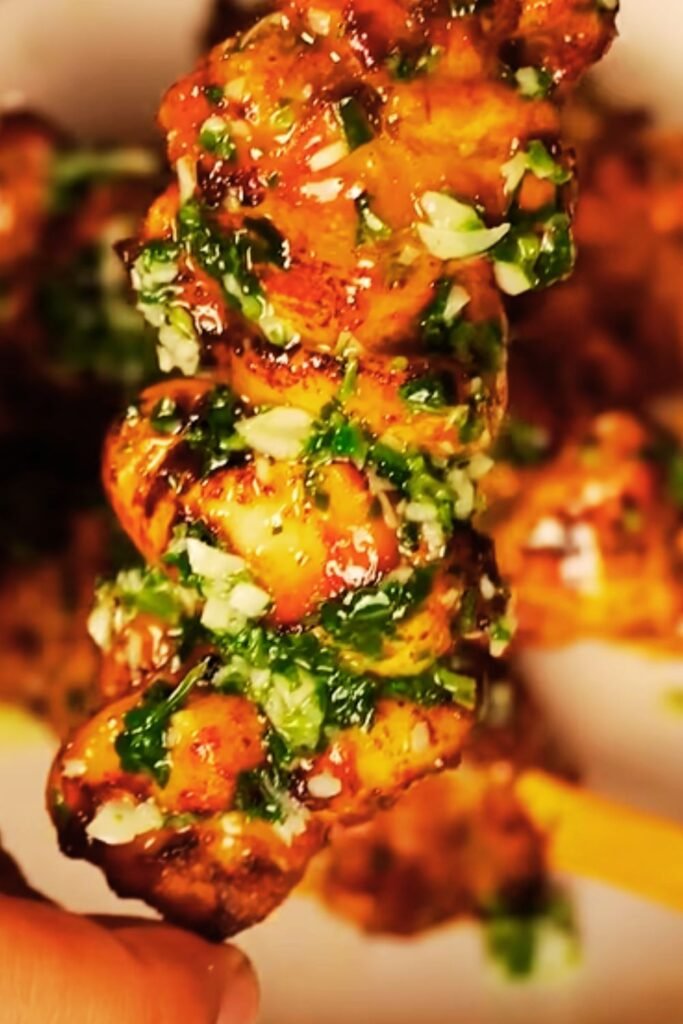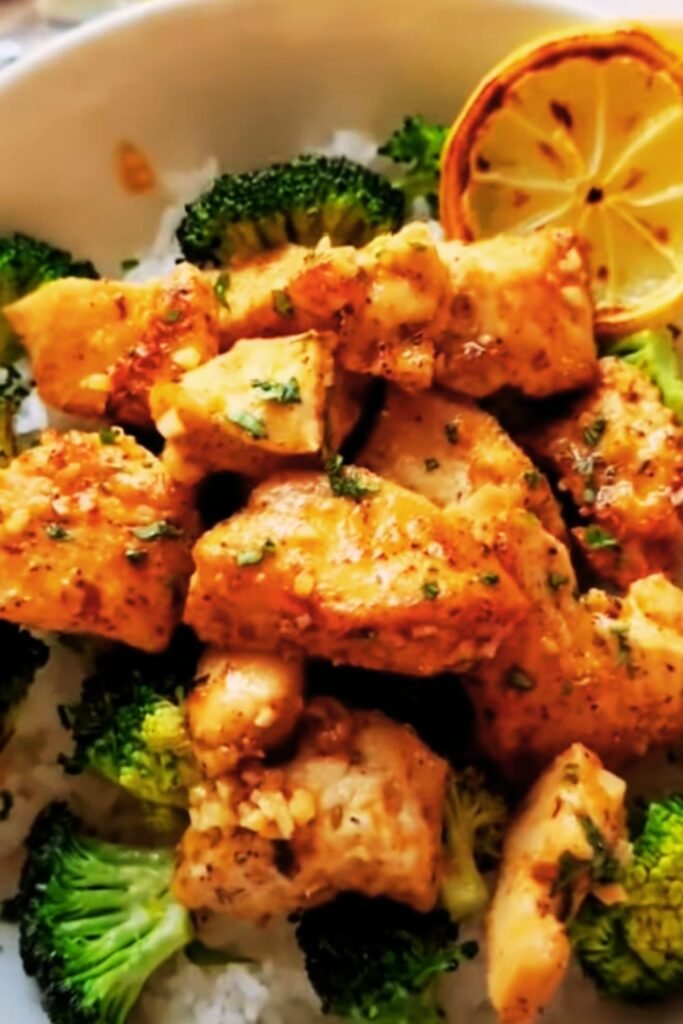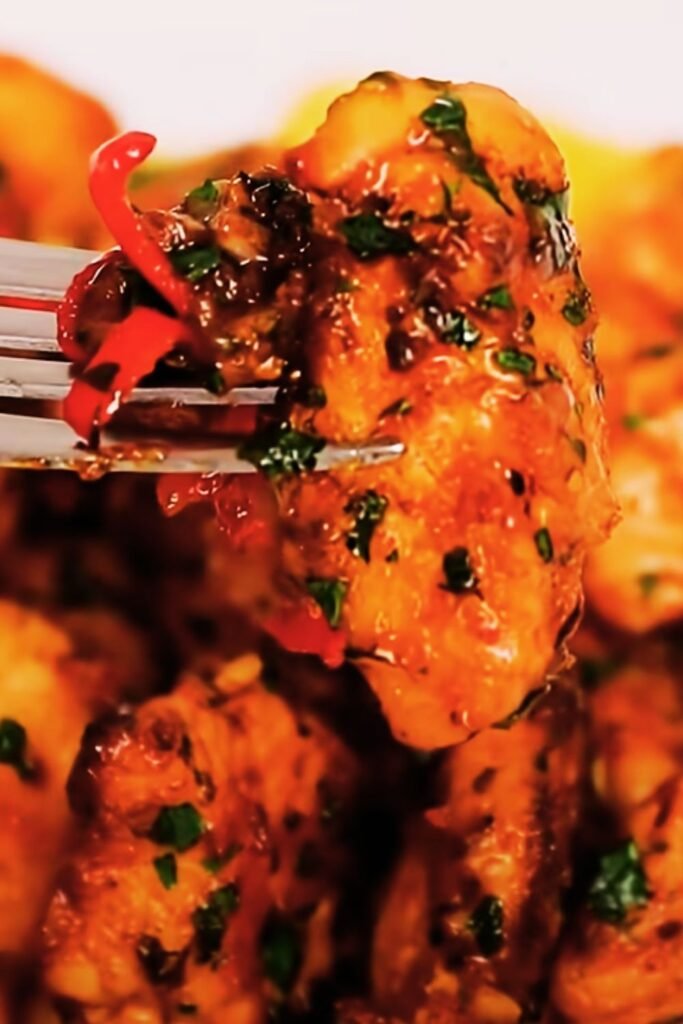There’s something magical about the combination of tender chicken and rich, aromatic garlic butter. I’ve been making these garlic butter chicken bites for years, and they never fail to impress whether I’m cooking for my family on a busy weeknight or entertaining guests. These bite-sized morsels are crispy on the outside, juicy on the inside, and absolutely bursting with flavor.
What makes this recipe special is how it transforms simple chicken into something extraordinary. The garlic butter sauce doesn’t just coat the chicken – it infuses every piece with incredible depth of flavor. I love how versatile these chicken bites are too. They work perfectly as an appetizer, main dish, or even as a protein-packed snack.
What Are Garlic Butter Chicken Bites?
Garlic Butter Chicken Bites : Small, cube-shaped pieces of chicken breast or thighs that are seasoned, cooked until golden, and tossed in a rich garlic butter sauce
Pan-Searing : A cooking method that involves cooking food in a hot pan with oil to create a golden, caramelized exterior while keeping the interior moist
Compound Butter : Butter that has been mixed with herbs, spices, or other flavorings – in this case, garlic and herbs
Caramelization : The browning process that occurs when proteins and sugars are exposed to high heat, creating complex flavors and appealing color
These chicken bites represent comfort food at its finest. Unlike traditional chicken preparations that can be heavy or overly complicated, these bites offer all the satisfaction of a hearty meal in a more approachable format. The beauty lies in their simplicity – quality ingredients treated with respect and cooked with care.
Why I Love This Recipe
I discovered this recipe during one of those hectic weeks when I needed something quick but didn’t want to compromise on flavor. My family was getting tired of the same old chicken dishes, and I wanted to create something that would excite them again. These garlic butter chicken bites were the perfect solution.
What impressed me most was how the garlic butter transforms ordinary chicken into something restaurant-worthy. The butter carries the garlic flavor into every nook and cranny of the chicken, while herbs like parsley and thyme add freshness that balances the richness. The result is chicken that’s incredibly flavorful but not overwhelming.
I also appreciate how forgiving this recipe is. Whether you’re a beginner cook or an experienced chef, these chicken bites are nearly impossible to mess up. The key is getting good color on the chicken and not overcooking it – two things that become second nature with just a little practice.

Essential Ingredients Breakdown
The beauty of this recipe lies in its simplicity, but each ingredient plays a crucial role in creating the final dish.
Primary Ingredients
| Ingredient | Amount | Purpose | Substitution Options |
|---|---|---|---|
| Chicken breast or thighs | 2 lbs | Main protein | Turkey breast, pork tenderloin |
| Butter | 4 tablespoons | Base for sauce | Ghee, olive oil blend |
| Fresh garlic | 6-8 cloves | Primary flavoring | Garlic powder (1 tsp per clove) |
| Fresh parsley | 1/4 cup | Freshness and color | Cilantro, chives, basil |
| Salt | 1 teaspoon | Seasoning | Sea salt, kosher salt |
| Black pepper | 1/2 teaspoon | Spice | White pepper, cayenne |
| Paprika | 1 teaspoon | Color and mild heat | Smoked paprika, chili powder |
| Olive oil | 2 tablespoons | Cooking medium | Avocado oil, vegetable oil |
Optional Enhancement Ingredients
| Ingredient | Amount | Purpose | When to Add |
|---|---|---|---|
| Lemon juice | 1 tablespoon | Brightness | Final toss |
| Red pepper flakes | 1/4 teaspoon | Heat | With garlic |
| Fresh thyme | 1 teaspoon | Earthy flavor | With parsley |
| Grated parmesan | 2 tablespoons | Umami | Final garnish |
| White wine | 2 tablespoons | Deglazing | After initial cooking |
I prefer using chicken thighs when possible because they stay more tender and flavorful than breasts, but both work beautifully. The key is cutting them into uniform pieces so they cook evenly.
Step-by-Step Cooking Process
Creating perfect garlic butter chicken bites is all about timing and technique. Here’s my foolproof method:
Preparation Phase
I start by preparing all my ingredients before heating the pan. This is crucial because once you start cooking, everything moves quickly.
- Cut chicken into 1-inch cubes, ensuring uniform size
- Mince garlic finely – I prefer using a microplane for the smoothest texture
- Chop parsley and measure all seasonings
- Have butter at room temperature for easier melting
Seasoning the Chicken
In a large bowl, I toss the chicken pieces with salt, pepper, and paprika. I make sure every piece is evenly coated. The seasoning not only flavors the chicken but helps create that beautiful golden crust we’re after.
The Cooking Process
Initial Searing:
- Heat olive oil in a large skillet over medium-high heat
- When the oil shimmers, add chicken pieces in a single layer
- Don’t overcrowd – work in batches if necessary
- Let chicken cook undisturbed for 2-3 minutes until golden
- Turn pieces and cook another 2-3 minutes
Creating the Garlic Butter:
- Reduce heat to medium-low
- Add butter to the pan, letting it melt around the chicken
- Add minced garlic and cook for 30 seconds until fragrant
- Toss chicken to coat evenly with the garlic butter
Final Touches:
- Add fresh herbs and any optional ingredients
- Toss everything together for final 30 seconds
- Taste and adjust seasoning if needed

Cooking Tips and Techniques
Temperature Control
Temperature management is crucial for perfect chicken bites. I start with high heat to get good searing, then reduce to prevent the garlic from burning. Garlic can go from golden to bitter very quickly, so watch it carefully.
Achieving Perfect Texture
The goal is chicken that’s golden brown outside and juicy inside. Here are my secrets:
- Don’t move the chicken too soon – Let it develop that golden crust before turning
- Use a meat thermometer – Internal temperature should reach 165°F (74°C)
- Rest the meat briefly – Even a minute or two helps juices redistribute
Flavor Development
The garlic butter sauce is where the magic happens. I’ve learned that:
- Fresh garlic is non-negotiable – the flavor is incomparably better than powder
- Room temperature butter incorporates more smoothly
- Fresh herbs should be added at the end to preserve their bright flavor
Common Mistakes to Avoid
Through trial and error, I’ve identified several pitfalls:
- Overcrowding the pan leads to steaming instead of searing
- High heat with butter can cause burning – reduce temperature when adding butter
- Overcooking makes chicken tough and dry
- Adding garlic too early can result in bitter flavors
Nutritional Information and Health Benefits
These garlic butter chicken bites offer impressive nutritional value while being absolutely delicious.
Nutritional Breakdown (Per Serving, Serves 4)
| Nutrient | Amount | % Daily Value | Health Benefits |
|---|---|---|---|
| Calories | 285 | 14% | Moderate calorie content |
| Protein | 32g | 64% | Muscle building and repair |
| Fat | 15g | 19% | Essential fatty acids |
| Carbohydrates | 2g | 1% | Low-carb friendly |
| Sodium | 420mg | 18% | Electrolyte balance |
| Vitamin B6 | 0.8mg | 47% | Brain function support |
| Niacin | 12mg | 75% | Energy metabolism |
| Phosphorus | 220mg | 31% | Bone health |
Health Benefits
High-Quality Protein: Chicken provides all essential amino acids needed for muscle maintenance and growth. This makes these bites perfect for anyone focused on fitness or maintaining muscle mass.
Heart-Healthy Fats: When prepared with olive oil and moderate butter, these bites provide beneficial monounsaturated fats that support cardiovascular health.
Antioxidant Power: Garlic contains allicin and other compounds with anti-inflammatory and immune-supporting properties. Fresh herbs like parsley add vitamin C and additional antioxidants.
Low Carbohydrate: With only 2 grams of carbs per serving, these chicken bites fit perfectly into low-carb, keto, or paleo dietary approaches.
Serving Suggestions and Pairings
One reason I love this recipe is its incredible versatility. These chicken bites work in so many different contexts.
As an Appetizer
When serving as appetizers, I arrange them on a platter with toothpicks and small bowls of dipping sauces. Popular options include:
- Creamy ranch dressing
- Honey mustard
- Spicy aioli
- Tzatziki sauce
- Buffalo sauce for heat lovers
Main Dish Pairings
As a main course, these chicken bites pair beautifully with various sides:
Starch Options:
- Garlic mashed potatoes
- Wild rice pilaf
- Herb-roasted baby potatoes
- Creamy polenta
- Buttered egg noodles
Vegetable Companions:
- Roasted Brussels sprouts
- Sautéed green beans
- Grilled asparagus
- Caramelized carrots
- Steam-roasted broccoli
Salad Pairings:
- Caesar salad
- Mixed greens with lemon vinaigrette
- Arugula and parmesan salad
- Mediterranean cucumber salad

Creative Serving Ideas
I’ve discovered some wonderful ways to incorporate these chicken bites into other dishes:
- Pasta Addition: Toss with fettuccine and extra garlic butter for an instant dinner
- Salad Topper: Add warm chicken bites to fresh greens for a protein-packed salad
- Rice Bowl: Serve over jasmine rice with steamed vegetables
- Wrap Filling: Use in tortillas with fresh vegetables and sauce
- Pizza Topping: Add to homemade or store-bought pizza for extra protein
Storage and Meal Prep
These chicken bites are fantastic for meal prep, and I often make double batches for the week ahead.
Refrigerator Storage
Cooked chicken bites keep well in the refrigerator for up to 4 days. I store them in airtight containers, separating layers with parchment paper to prevent sticking. The garlic butter may solidify when cold, but it melts beautifully when reheated.
Freezing Instructions
For longer storage, these chicken bites freeze exceptionally well for up to 3 months. Here’s my process:
- Cool chicken bites completely before freezing
- Arrange on a baking sheet in a single layer
- Freeze until solid (about 2 hours)
- Transfer to freezer bags, removing excess air
- Label with date and contents
Reheating Methods
Stovetop (Preferred): Heat a skillet over medium heat, add a little butter or oil, and warm chicken bites for 3-4 minutes, stirring occasionally.
Oven: Reheat at 350°F (175°C) for 8-10 minutes, covered with foil to prevent drying.
Microwave: Use 50% power in 30-second intervals, stirring between, until heated through.
Recipe Variations and Adaptations
Over the years, I’ve developed several variations of this basic recipe to keep things interesting.
International Flavors
Mediterranean Style:
- Add sun-dried tomatoes and olives
- Use oregano and basil instead of parsley
- Finish with crumbled feta cheese
Asian-Inspired:
- Replace butter with sesame oil
- Add ginger and scallions
- Finish with sesame seeds and soy sauce
Mexican Variation:
- Season with cumin and chili powder
- Add lime juice and cilantro
- Serve with avocado and jalapeños
Dietary Adaptations
Dairy-Free Version:
- Use ghee or olive oil instead of butter
- Add nutritional yeast for umami flavor
Keto-Friendly:
- Use chicken thighs for higher fat content
- Add extra butter and herbs
- Serve with cauliflower rice
Whole30 Compliant:
- Use ghee instead of butter
- Ensure all seasonings are compliant
- Focus on fresh herbs for flavor
Troubleshooting Common Issues
Even with a straightforward recipe like this, sometimes things don’t go as planned. Here are solutions to common problems I’ve encountered:
Problem: Chicken Turns Out Dry
Causes:
- Overcooking
- Using chicken breasts that are too thick
- Not using enough fat
Solutions:
- Use a meat thermometer to avoid overcooking
- Pound chicken to even thickness before cutting
- Don’t skip the butter – it keeps chicken moist
Problem: Garlic Tastes Bitter
Causes:
- Cooking garlic at too high heat
- Adding garlic too early in the process
Solutions:
- Reduce heat before adding garlic
- Add garlic after chicken is nearly cooked
- Use fresh garlic, not pre-minced
Problem: Chicken Doesn’t Brown Well
Causes:
- Pan not hot enough
- Overcrowding the pan
- Chicken pieces too wet
Solutions:
- Preheat pan properly before adding oil
- Cook in batches if necessary
- Pat chicken dry before seasoning
Q&A Section
Q: Can I use frozen chicken for this recipe?
I don’t recommend using frozen chicken directly. The excess moisture from thawing will prevent proper browning and can make the chicken tough. Always thaw chicken completely and pat it dry before cooking.
Q: What’s the best way to cut chicken into uniform pieces?
I place the chicken breast on a cutting board and slice it horizontally to create even thickness, then cut into 1-inch cubes. Using a sharp knife makes this much easier and safer.
Q: Can I make this recipe in advance for a party?
Absolutely! I often make these chicken bites a few hours ahead and keep them warm in a slow cooker on the “warm” setting. They actually get more flavorful as they sit in the garlic butter.
Q: How do I know when the chicken is fully cooked?
The most reliable method is using a meat thermometer – chicken should reach 165°F (74°C) internally. Visually, the chicken should be golden brown outside and white throughout with no pink areas.
Q: Can I use garlic powder instead of fresh garlic?
While fresh garlic gives the best flavor, you can substitute garlic powder in a pinch. Use about 1/4 teaspoon of garlic powder per fresh clove, and add it with the other dry seasonings rather than to the hot butter.
Q: Why does my butter separate from the chicken?
This usually happens when the temperature is too high or the butter is added too quickly. Reduce heat to medium-low before adding butter, and let it melt slowly. If it separates, remove from heat and whisk gently to re-emulsify.
Q: Can I double or triple this recipe?
Yes, but you’ll need to cook the chicken in batches to avoid overcrowding. Use a larger skillet or multiple pans, and keep the first batch warm while cooking subsequent batches.
Q: What other herbs work well in this recipe?
I love experimenting with different herbs! Thyme, rosemary, sage, and chives all work beautifully. Just remember that stronger herbs like rosemary should be used more sparingly.
Q: Is there a way to make this recipe spicier?
Definitely! I add red pepper flakes with the garlic, or sometimes I’ll use a pinch of cayenne pepper in the initial seasoning. Hot sauce can also be drizzled on at the end.
Q: Can I use this recipe for meal prep?
These chicken bites are excellent for meal prep. I portion them into containers with different sides throughout the week. They reheat well and actually develop more flavor over time.
This garlic butter chicken bites recipe has become one of my go-to dishes for good reason. It’s simple enough for weeknight dinners but special enough for company. The combination of perfectly seasoned chicken and rich, aromatic garlic butter creates something truly memorable. Whether you’re cooking for family or entertaining friends, these chicken bites deliver on both flavor and satisfaction every single time.